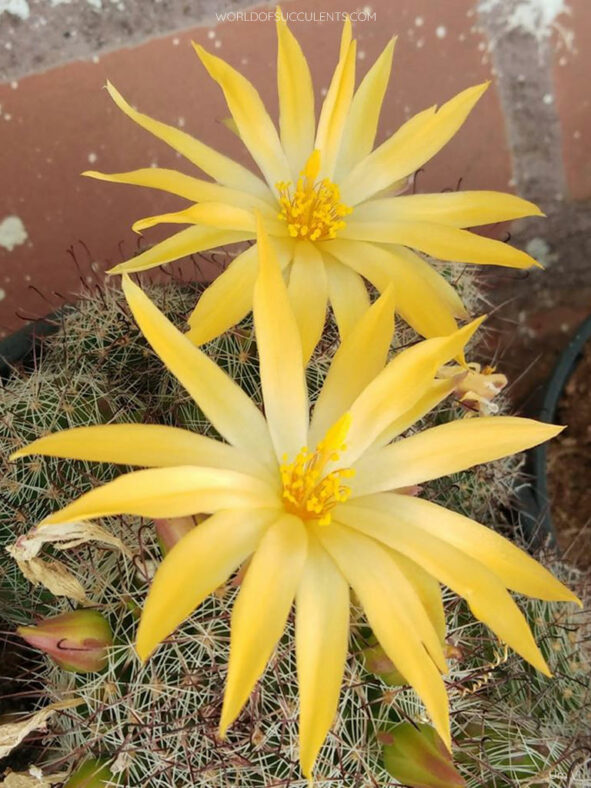Mammillaria beneckei is a widely distributed species with a highly variable size, spines, and flower color. It was first described by Carl August Ehrenberg in 1844.
Scientific Name
Mammillaria beneckei C.Ehrenb.
Common Name(s)
Benecke Fishhook Cactus, Benecke's Nipple Cactus
Synonym(s)
Cactus beneckei, Dolichothele beneckei, Oehmea beneckei
Scientific Classification
Family: Cactaceae
Subfamily: Cactoideae
Tribe: Cacteae
Subtribe: Cactinae
Genus: Mammillaria
Etymology
The specific epithet "beneckei" (pronounced "bee-NEK-ee-eye") honors the Berlin-born trader Stephan (Etienne) Benecke (1808-1879), who emigrated to Mexico.
Origin
Mammillaria beneckei is native to Mexico. It occurs at low elevations in Sinaloa, Nayarit, Jalisco, Colima, Michoacán, Mexico, Guerrero, and Oaxaca.
Description
Mammillaria beneckei is a small cactus with green to greenish-brown stems covered with broadly conical tubercles. Initially growing solitary, it forms a large clump up to 20 inches (50 cm) in diameter or more over time. The stems are depressed, spherical to short cylindrical, and can grow up to 4 inches (10 cm) tall and 2.8 inches (7 cm) in diameter. The tubercles are soft, broadly conical, and often tinged with reddish or purple. Each tubercle has an areole with a cluster of spines at its tip. The axils of the tubercles are covered with a bit of wool and sparse bristles. The areoles bear 2 to 6 central and 12 to 15 radial spines. The central spines are brown or black, usually hooked, measuring up to 0.5 inches (1.2 cm) long, while the radial spines are needle-like, white or yellow with a dark tip, measuring up to 0.3 inches (0.8 cm) long.
In spring, Mammillaria beneckei produces fragrant, funnel-shaped flowers with petals in various shades of yellow to almost orange. They can reach a length of 1.2 inches (3 cm) and are nearly equal in diameter. The fruits are red, club-shaped, and contain dark brown seeds.

How to Grow and Care for Mammillaria beneckei
Light: For optimal growth, Mammillaria beneckei must be planted in an area that receives at least four hours of direct sunlight daily. It should be placed near a bright window to ensure it gets enough light if grown indoors. It is advisable to keep it on the balcony or in the garden from spring to fall.
Soil: Use commercial cactus soil or create your own well-draining soil mix to ensure good root aeration and drainage.
Temperature: Mammillaria beneckei is heat-tolerant but not cold-hardy. It grows best in USDA Plant Hardiness Zones 9b to 11b, with average minimum winter temperatures ranging from 25°F to 50°F (-3.9°C to 10°C).
Watering: Water deeply from spring to fall, and wait until the soil dries out before watering again. Never let your pot sit in water, and suspend watering when the plant goes dormant in the winter.
Fertilizing: Mammillaria beneckei benefits from fertilizing during the growing season. Apply a water-soluble fertilizer for cacti and succulents. Suspend feeding during the winter when the plant goes dormant.
Repotting: Repot the cactus into a slightly larger pot every two or three years, preferably in late winter or early spring. However, repotting can be done at any time of the year.
Propagation: There are two easy ways to propagate Mammillaria beneckei: by seeds or by dividing offsets. The best time to remove offsets is in spring and summer. Sow the seeds in late spring or summer for the best results.
Learn more at How to Grow and Care for Mammillaria.
Toxicity of Mammillaria beneckei
Mammillaria beneckei is non-toxic but has sharp spines, so keep it away from children and pets.
Links
- Back to genus Mammillaria
- Succupedia: Browse succulents by Scientific Name, Common Name, Genus, Family, USDA Hardiness Zone, Origin, or cacti by Genus
Photo Gallery
Click on a photo to see a larger version.


